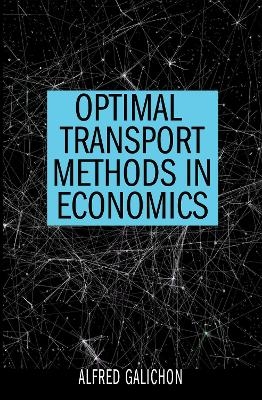
Optimal Transport Methods in Economics
Princeton University Press (Verlag)
9780691183466 (ISBN)
Authoritative and accessible, Optimal Transport Methods in Economics also features numerous exercises throughout that help you develop your mathematical agility, deepen your computational skills, and strengthen your economic intuition.
The first introduction to the subject written especially for economists
Includes programming examples
Features numerous exercises throughout
Ideal for students and researchers alike
Alfred Galichon holds joint appointments in the Department of Economics and the Courant Institute of Mathematical Sciences at New York University. He is on the editorial boards of the Review of Economic Studies and Economic Theory and is a research fellow at the Center for Economic and Policy Research (CEPR) and the Institute for the Study of Labor (IZA).
Preface xi
1 Introduction 1
1.1 A Number of Economic Applications 1
1.2 A Mix of Techniques 3
1.3 Brief History 4
1.4 Literature 5
1.5 About These Notes 6
1.6 Organization of This Book 7
1.7 Notation and Conventions 9
2 Monge-Kantorovich Theory 11
2.1 Couplings 11
2.2 Optimal Couplings 13
2.3 Monge-Kantorovich Duality 14
2.4 Equilibrium 18
2.5 A Preview of Applications 19
2.6 Exercises 22
2.7 References and Notes 23
3 The Discrete Optimal Assignment Problem 24
3.1 Duality 25
3.2 Stability 26
3.3 Pure Assignments 27
3.4 Computation via Linear Programming 29
3.5 Exercises 32
3.6 References and Notes 33
4 One-Dimensional Case 34
4.1 Copulas and Comonotonicity 35
4.2 Supermodular Surplus 36
4.3 The Wage Equation 40
4.4 Numerical Computation 42
4.5 Exercises 43
4.6 References and Notes 44
5 Power Diagrams 45
5.1 Hotelling's Location Model 45
5.2 Capacity Constraints 48
5.3 Computation via Convex Optimization 53
5.4 Exercises 54
5.5 References and Notes 56
6 Quadratic Surplus 57
6.1 Convex Analysis from the Point of View of Optimal Transport 57
6.2 Main Results 60
6.3 Vector Quantiles 63
6.4 Polar Factorization 65
6.5 Computation by Discretization 68
6.6 Exercises 69
6.7 References and Notes 70
7 More General Surplus 72
7.1 Generalized Convexity 72
7.2 The Main Results 76
7.3 Computation by Entropic Regularization 78
7.4 Exercises 79
7.5 References and Notes 80
8 Transportation on Networks 81
8.1 Setup 82
8.2 Optimal Flow Problem 87
8.3 Integrality 90
8.4 Computation via Linear Programming 91
8.5 Exercises 93
8.6 References and Notes 94
9 Some Applications 95
9.1 Random Sets and Partial Identification 95
9.2 Identification of Discrete Choice Models 98
9.3 Hedonic Equilibrium 101
9.4 Identification via Vector Quantile Methods 104
9.5 Vector Quantile Regression 106
9.6 Implementable Mechanisms 110
9.7 No-Arbitrage Pricing of Financial Derivatives 115
9.8 References and Notes 117
10 Conclusion 118
10.1 Mathematics 118
10.2 Computation 119
10.3 Duality 120
10.4 Toward a Theory of "Equilibrium Transport" 122
10.5 References and Notes 123
A Solutions to the Exercises 125
A.1 Solutions for Chapter 2 125
A.2 Solutions for Chapter 3 128
A.3 Solutions for Chapter 4 130
A.4 Solutions for Chapter 5 133
A.5 Solutions for Chapter 6 137
A.6 Solutions for Chapter 7 139
A.7 Solutions for Chapter 8 141
B Linear Programming 144
B.1 Minimax Theorem 144
B.2 Duality 144
B.3 Link with Zero-Sum Games 146
B.4 References and Notes 148
C Quantiles and Copulas 149
C.1 Quantiles 149
C.2 Copulas 151
C.3 References and Notes 153
D Basics of Convex Analysis 154
D.1 Convex Sets 154
D.2 Convex Functions 155
D.3 References and Notes 159
E McFadden's Generalized Extreme Value Theory 160
E.1 References and Notes 160
References 161
Index 169
| Erscheinungsdatum | 20.09.2018 |
|---|---|
| Verlagsort | New Jersey |
| Sprache | englisch |
| Maße | 152 x 235 mm |
| Themenwelt | Wirtschaft ► Allgemeines / Lexika |
| Wirtschaft ► Volkswirtschaftslehre ► Mikroökonomie | |
| Wirtschaft ► Volkswirtschaftslehre ► Ökonometrie | |
| ISBN-13 | 9780691183466 / 9780691183466 |
| Zustand | Neuware |
| Informationen gemäß Produktsicherheitsverordnung (GPSR) | |
| Haben Sie eine Frage zum Produkt? |
aus dem Bereich


